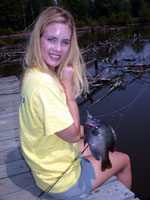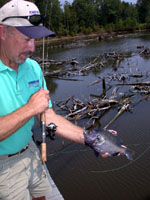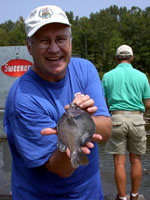
|
Features
|
|
|
|
Books
|
|
|
|
Fun & Games
|
|
|
|
Contact Us
|
|
|
John's Journal... Entry 164, Day 4
GIANT BLUEGILLS
Help Your Farm Pond Produce Better
 EDITOR'S
NOTE: Barry Smith of Montgomery, Alabama, a longtime fisheries biologist,
co-owns American Sport Fish in Pike Road, Alabama, one of the largest
private hatcheries in the Southeast, with his partner Don Keller. Smith
and Keller have developed several breeds of fish that landowners enjoy
stocking in their ponds. This week we'll talk with Smith about the giant
bluegills American Sport Fish stocks.
EDITOR'S
NOTE: Barry Smith of Montgomery, Alabama, a longtime fisheries biologist,
co-owns American Sport Fish in Pike Road, Alabama, one of the largest
private hatcheries in the Southeast, with his partner Don Keller. Smith
and Keller have developed several breeds of fish that landowners enjoy
stocking in their ponds. This week we'll talk with Smith about the giant
bluegills American Sport Fish stocks.
Question: I've heard that you shouldn't stock catfish
in your pond with bluegill and bass if you want to grow trophy bluegills?
Is this true, and if yes, why?
Answer: That is true in two situations. If you want to grow trophy bluegills
or trophy bass, I recommend not putting catfish in your pond. Catfish
will compete with both your bluegill and your bass for food. Even if you
stock only 100 catfish per acre, and you don't harvest these fish out
-- let's say you only harvest half of the stock per acre per year and
then only have 50 catfish in your pond per acre per year and those catfish
grow for four or five years and then weigh 5- to 8-pounds each -- you
don't need to be a rocket scientist to realize that you have hundreds
of pounds of catfish in your pond that are eating all the little fish
that the bluegills and the bass would eat, if they had the chance.
 Question:
So we need to keep this pond free of catfish, right?
Question:
So we need to keep this pond free of catfish, right?
Answer: If you want to manage for trophy fishing, that's my suggestion.
If you just want an all-around fishing pond and you aren't interested
in trophy bass or trophy bluegills, that's fine.
Question: What about putting in weeds or brush in your
pond? Is it necessary or recommended?
Answer: Brush is good for ponds because it concentrates some of your fish
and will provide an attachment surface for aquatic insects which bluegills
eat. So, all of those types of things are beneficial. I don't necessarily
recommend stocking weeds in your pond, although there are some types of
plants which look good aesthetically and do provide some cover and if
maintained properly can be very functional.
 Question:
Another bluegill species that people have really gotten excited about
is the hand-painted bluegill. What is this species, and what are your
thoughts about hand-painted bluegills?
Question:
Another bluegill species that people have really gotten excited about
is the hand-painted bluegill. What is this species, and what are your
thoughts about hand-painted bluegills?
Answer: The hand-painted bluegill, a very pretty fish, is a different
subspecies that's found in isolated places in Florida. We actually spawned
these fish 15-16 years ago. We liked them, but we didn't have a market
for them. We haven't mass-produced them because we didn't have the market
for them; we just couldn't sell them. But the hand-painted bluegill is
an excellent fish with a very good growth rate. I haven't seen any scientific
studies on the comparison of their birth rates compared to the coppernose,
but I assume it's very similar.
Question: So you would assume that they grow as fast
as the common bluegill?
 Answer:
That's quite likely. For someone concerned with aesthetics, the hand-painted
bluegill would be a good choice since they are so pretty. The only problem
is that these fish are not available commercially. There's not any hatcheries
that raise these fish, so if you want some, they're not available on the
common market.
Answer:
That's quite likely. For someone concerned with aesthetics, the hand-painted
bluegill would be a good choice since they are so pretty. The only problem
is that these fish are not available commercially. There's not any hatcheries
that raise these fish, so if you want some, they're not available on the
common market.
To learn more about American Sport Fish, write P.O. Box 20050, Montgomery, AL 36120, or call (334) 281-7703.
TOMORROW: FACTS ABOUT COPPERNOSE BLUEGILLS
Check back each day this week for more GIANT BLUEGILLS ...
Day 1 - Giant Bluegills
Day 2 - How to Prepare Your Pond to Grow
Super Bluegills
Day 3 - How to Have a Pond with the Most-Catchable
Big Bluegills
Day 4 - Help Your Farm Pond Produce Better
Day 5 - Facts About Coppernose Bluegills